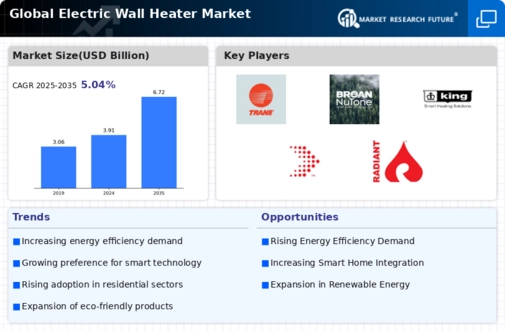Market Share
Electric Wall Heater Market Share Analysis
Companies adopt different market share positioning strategies in the competition-saturated environment of electric wall heater markets to stand out from other competitors and to attract customers' notice. One popular strategy is differentiation which involves the unique characteristics and functionalities that many companies highlight to set their products apart from the other brands in the market. This tactic leads consumers into repetitive business and loyalty over the brand. For example, some firms may bring innovative technologies like smart thermostats, energy efficiency or the enhanced safety measures to differentiate their products in the market. Another very popular strategy is of cost leadership, where the company wants to be a low-cost producer in the market. This includes improving the processes of production, obtaining the materials effectively and reaching scale economies. With their cost-effective proposition, without sacrificing quality, companies can attract price conscious customers and also increase share. Nevertheless, the cost leadership is only sustainable through a never-ending quest for improvement in the process and efficient supply chain management. Market segmentation also forms a very critical component of the market share positioning strategies. The company may focus on a particular segment of the consumers due to demographic, psychometric or geographical considerations. For instance, a company could produce an electric-wall heater product line specifically designed for environmentally conscious customers who value the energy efficiency and sustainability aspects. By identifying the varied requirements of various market segments, companies can customize their products and messaging to the targeted audiences thus succeeding in taking a competitive advantage over these markets. It has the same pivotal role in the market share positioning. Companies that spend money on research and development to come up with the innovative electric wall heaters can create a niche market for themselves. Innovation drives the consumers to purchase new heating technologies, sleek designs, or user-friendly interfaces as the latest and most advanced products. Adhering to the technology trends allows companies not only to see themselves as industry leaders, but also drives customers to opt for products of these firms instead of the competitors. Market share positioning largely results from the strategic partnerships and collaborations. Companies can enter into the business partnerships, such as home automation system providers or construction companies, to increase their markets and offer bundled solutions. Such collaborations may generate many synergy that heightens the overall value proposition for the consumers. For example, such partnership as with the company specialising in home automation can result into integration of electric wall heaters that connects to the smart home systems offering consumers a consistent connected experience.









Leave a Comment